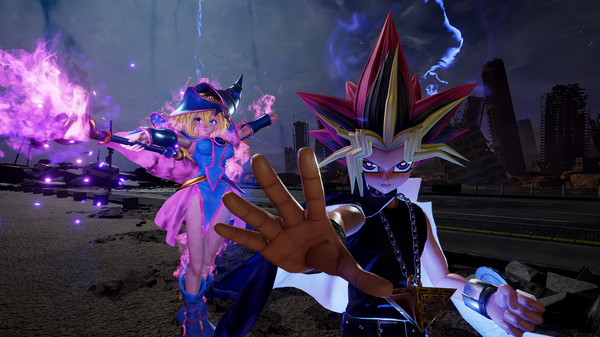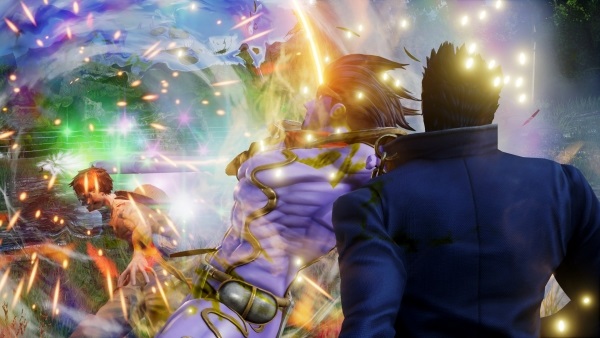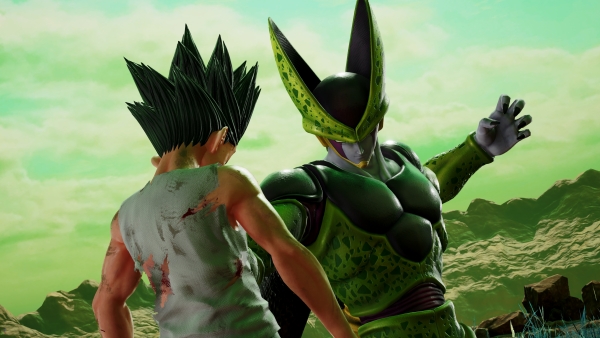Anime Editor
Review: Jump Force (Sony PlayStation 4)
Review by Clark A.
On paper, the highly anticipated Jump Force evokes memories of 2014’s J-Stars Victory VS. They’re both arena fighting games starring the cast of Japan’s best-selling weekly manga anthology, Shōnen Jump magazine. As anniversary releases, they celebrate the spirit of the publication and the unforgettable faces native to those pages.
Although J-Stars had a relatively milquetoast reception, the second Jump Force was unveiled at E3, it commanded attention. You had Luffy, star of the most popular manga in the world, standing on an American flag while Dragon Ball’s most twisted villain, Freiza, decimated the buildings of New York City. The manga icons shown off suddenly had less cartoonish bodies to better suit the atmosphere of Times Square. Throw in an ominous narrator and Jump Force looked to have a genuine vision for a crossover game.
Eight months later, Jump Force has landed and no longer has that air of intangibility surrounding it. It indeed offers the high octane anime clashes it marketed. Alas, that E3 trailer also reflects what Jump Force tries and fails to be, casting a shadow over its accomplishments.
The story kicks off as that New York City trailer did. Mega popular Shōnen Jump mascots fend off the aforementioned threat of Frieza, but not without a toll. The “player” is killed during this scuffle and revived by Trunks (Dragon Ball Z) at the price of turning them into a super powered being. Trunks introduces the player to the Jump Force organisation, a group of Shōnen Jump heroes defending humanity from lurking threats. These include villains, possessed heroes, and other humans called Venoms made to work for mysterious forces. It’s a premise designed to get all the manga characters into one place, yes, but should function well as a setup for a crossover game.
From there you’re sent to design your avatar. Character creation is heavily based on entities already in the game, plus some that resemble familiar characters. Cynics might call it a reshuffling of existing assets and optimists might say it maintains stylistic consistency. However you feel, it has led to convincing approximations of characters that didn’t make the roster such as Neferpitou and Android 18 so it’s good enough for me. You can expect options not dissimilar to Bandai Namco’s Dragon Ball Xenoverse games; sufficient for individuality but not enough to reinvent the wheel. The outfits you collect in-game are also based on existing assets so you can make outlandish combinations such as Ichigo’s kimono with Yugi’s hair.
As the latest member of the Jump Force, you’re tasked with completing missions. The basic formula is to rescue possessed heroes and recruit them into Jump Force then occasionally seek an exclamation mark in the hub world to advance the story. Players are given the choice of working for Goku from Dragon Ball, Luffy from One Piece, or the eponymous Naruto. Each leader runs an area of the hub world, but they’re all much the same and have little impact in the grand scheme of things. In fact, I question why said hub world exists rather than a spiffy menu. The plaza is quite barren compared to the likes of Dragon Ball Xenoverse, a fellow Bandai Namco-published title in a similar vein. The bulk of your interactions will be spent walking to a booth and recruiting more iconic members into the Jump Force.
As for the characters you’ll employ, they’re notably different than J-Stars. J-Stars usually topped out at three characters per Jump series. The rosters in both games are around the same (40) but Jump Force gives Naruto, Dragon Ball, and One Piece six members each. Hunter x Hunter and Bleach aren’t far off with four. I do lament the loss of Medaka and Korosensei. Thankfully, Jump Force provides a couple creative replacements such as Ryo from City Hunter and Yugi from you-know-what. On the other hand again, J-Stars also brought over a dozen support characters along for the ride, whereas Jump Force lacks that level of fanservice. The bottom line is that J-Stars has a diverse roster better suited to an anniversary game, but Jump Force’s reflects a worldwide market and the game’s tone.
The setup for recruiting these otherworldly fighters is typically Jump Force’s Director Glover sending your avatar with some Jump representative to a real world location such as the Alps. Your avatar’s partner might have a connection to the target or it can appear arbitrary. Unfortunately, these scenes get old quickly because the writers cling to a rigid format that is mundane and uneventful the first time around. You arrive, a hero is suddenly possessed, then they comes to their senses once a malicious Umbra Cube is extracted after combat.
The dialogue between combatants is too brief to take flight and too stock to elicit any kind of emotion. It feels regurgitated and rephrased even by characters from completely different properties. The best written and most convincing interactions involve characters from the same universe. Typically that happens to be One Piece, but Gon and Killua from Hunter X Hunter have a meeting that should have set the minimum creative requirements. Killua’s intelligence and trust in Gon are actually demonstrated on screen and it puts a little spin on the standard formula. Unfortunately, these recruitments are the exception rather than the rule.
To illustrate how great these interactions could have been, look at Ichigo Kurosaki versus Yusuke Urameshi early in the story. Bleach takes heavy inspiration from Yuyu Hakusho and the protagonists have equivalent positions as high school students in modern society. Yusuke is crass, thuggish, and perverted, but under that exterior he’s willing to risk his life for a random child. Ichigo is perceived as a hooligan and gets into fights unwillingly, but he’ll tear down hierarchies and social standards if it means protecting people. They’re both rebellious high schoolers with missing parents, but their differences in etiquette and philosophy towards fighting could be the subject of amusing exchanges.
Even if the writers had no familiarity with either series, reading a volume of each demonstrates enough characterisation for comedic dialogue to write itself. Common knowledge will tell you they both fight monsters, work part time for spiritually aware organisations, and spend story arcs struggling with the nature of their bloodline. The list of comparisons is endless, but only a few lines of text are needed to give their skirmish some context or fanservice. What plays out in-game? Yusuke beats up a haunted Ichigo, who then acknowledges his opponent’s power and mentions Soul Society isn’t happy about the collision of worlds. It doesn’t feel like either character is actually standing there. No wisecracks, no winks to the audience, no effort at making the characters connect.
I didn’t walk into this anime crossover game expecting Orwellian writing nor fan fiction about Aizen’s steamy lust for Kaguya. It’s disheartening when a crossover merely puts characters in the same space. With Jump Force, it’s worse because these characters and the real world setting could facilitate all kinds of humour. Recent anime fighter My Hero One’s Justice failed to tell a cohesive story, but I can appreciate the difficulty involved in trying to convey three seasons of plot. Jump Force doesn’t have an excuse with access to 50 years of material for a crossover and numerous characters with blatant commonalities you could weave a paragraph or two around.
I’m not one to heavily critique cutscene animations so long as the story gets its point across, but Jump Force’s scenes can be…unsettling. The movements and expressions are jarring enough at times that it would have been better served with simple text and pretty 2D character portraits. I don’t want to dig too deep but we’re talking unfinished movement animations, missing voice lines in otherwise voiced scenes, and reflexive use of black screen transitions to seemingly avoid animating movement. My grander objection is that this exemplifies how the developers bit off more than they could chew, actively sacrificing the game’s overall polish as a result.
When not recruiting new Jump Force combatants, the game dishes out objectives that are as dull as the plot. Fighting Toguro from Yuyu Hakusho as Naruto is a fine idea. Doing it three times consecutively and then later with other characters is not. The writing and scenarios improve a tad around the game’s halfway point, but even then it’s limited and doesn’t make up for missed opportunities. A lot more screen time is given to brand new characters such as Director Glover, Galena, and Kane. Of course, they also have no history in Shōnen Jump and thus take time away from fanservice. Painfully obvious plot twists the viewer can predict the second a character is introduced don’t help matters. The non-playable Light Yagami from Death Note throws an amusing wrench into situations, thankfully, so there’s mild amusement to be had there.
On the actual fighting end of the spectrum, the game is a marked upgrade over J-Stars Victory VS. Jump Force opts for three on three combat like its predecessor but reinterprets the execution. Instead of having three simultaneous opponents in one arena, these are tag team matches. Characters on a team share a collective health bar too, so swapping out is really just scrolling through what attacks the player has access to at the time. This allows for speedier fights with newfound intensity. You can also call in allies to set up combos or bail you out of a tight situation. Those tweaks alone make the gameplay tighter than J-Stars in my estimation. You’re encouraged to switch characters frequently as an extension of your strategy rather than cleaning up the AI’s mess. You don’t need to worry about locking onto characters or memorising button combinations; it’s all straightforward.
The gameplay of arena fighters tends not to be as technical as upper echelon of competitive fighting games such as Street Fighter. Jump Force toes the line well enough to encourage a bit of skill but allow for casual enjoyment. The central systems here lend themselves better to conventional reading and countering than you’d anticipate. I wouldn’t bank on the game’s longevity in the competitive scene by any means but in this world of patches, online should be exciting for long enough. Due to the frenetic pace of combat, the game is more instantly accessible than J-Stars. It does value silly fun over competitive viability in some cases too. For instance, Sanji is a bit of a joke character as he’s completely unable to attack female characters. Thankfully, you can play around this by using the tag team mechanic so it’s not as if he’s unusable.
I’ve heard criticisms in the past that these kinds of anime fighters would be better served as classical 2D experiences and that’s frequently true. However, the battles in Jump Force probably wouldn’t be as high-energy and hard hitting in that dimension. The giant arenas fit well with the attacks featured and the nature of Shōnen Jump manga in general. The real world meets anime set pieces are often quite stunning too (even if they’re mostly just backdrops and not properly leveraged by the story). The feedback of basic movement and being launched across the map is just right. It all comes together quite nicely.
As a whole, the combat portion of the game does a better job of providing fanservice than the story mode ever does. The dialogue between fighters before a match is superior to what you’ll find in the story mode. Some cut corners, sure, but there’s a healthy mixture of comedy, seriousness, and fanservice. Killua calls out Asta from Black Clover for cockiness being his strategy, not fully grasping the extent to which that claim is correct. Yugi chastising Sasuke from Naruto for giving into the hatred in his heart is perfect for the King of Games and has extra weight if you’ve seen an anime filler arc. Blackbeard from One Piece inviting Toguro out for a drink is logical and a nice callback to a character-building scene where Toguro declares orange juice as his beverage of choice.
Whether or not you appreciate the added realism on these larger than life character models, there is great care put into capturing the intricacies of their designs. It’s not just in the chatter or character models either. All the famous attacks and techniques are here are authentic. When Piccolo uses his Makankosappo technique, it pierces through his opponent’s chest just like it did against Goku in Dragon Ball Z. When Yugi summons Slifer the Sky Dragon, you can see his sacrificed cards flying away. Even the battle damage helps to recreate manga scenes, such as Shiryu from Saint Seiya fighting without his protective cloth.
Awakenings allow characters to transform when the meter hits a certain level. Wait for it to max out and you can go even further beyond. In the case of Goku, that means going Super Saiyan Blue instead of classic Super Saiyan. This opens up new tools while also providing even more fanservice, what with transformations being a staple of Shōnen manga at this point. For those unfamiliar with the source material, there’s an awe factor in seeing what exciting or dreadful redesign awaits.
All this love and attention to detail makes me a bit sad, then. Many of the pre-battle interactions could been fleshed out into slightly longer skits that exhibit what makes each character interesting. You could make miniature arcade campaigns for each fighter not unlike Super Smash Bros. Ultimate. The tournament structure, clichéd as it is, represents a Shōnen Jump staple. Instead, we’re stuck with a story mode that needed far more time in the oven.
Jump Force fulfils its central purpose – anime fighting – splendidly. Instead of focusing on that brilliance, the developers piled disconnected features from other games on top. With better utilisation of fanservice and context for the characters present, this could have gone down as Bandai Namco’s best outing in the category, but the love still shines through.
Latest Articles
It’s that time of year again! We’re counting down the days to Christmas with our own…
It’s that time of year again! We’re counting down the days to Christmas with our own…
It’s that time of year again! We’re counting down the days to Christmas with our own…
Grizzly Man is the fourth title in LCB Game Studio’s Pixel Pulps series, beginning a second…
It’s that time of year again! We’re counting down the days to Christmas with our own…














